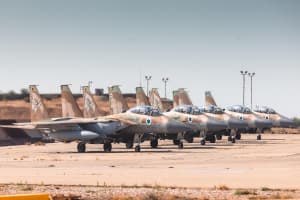US THAAD missile battery boosts Israel’s aerial defense against Houthi missiles

An American THAAD missile battery in Israel has boosted the Jewish state’s aerial defense capabilities. Yesterday, a missile from the THAAD system and one from the Israeli Arrow system intercepted and neutralized a barrage of missiles fired by the Iran-backed Houthi terrorist militia based in Yemen.
In October, then-U.S. Secretary of Defense Lloyd Austin informed Israel’s former defense minister, Yoav Gallant, that Washington would deploy a THAAD missile battery “to help bolster Israel's air defenses following Iran's unprecedented attacks against Israel on April 13 and again on October 1.”
The THAAD system, which is an abbreviation for Terminal High-Altitude Area Defense, is the American equivalent of the Israeli-developed Arrow system. Both aerial defense platforms are designed to intercept long-range ballistic missiles. Both were created and developed after the First Gulf War in 1991, when the U.S. Patriot missile system proved to be ineffective in intercepting the Scud missiles fired by Iraq against Israel.
Altogether, Iraq fired about 39 missiles against Tel Aviv and central Israel, causing considerable material damage and killing several Israeli civilians.
The American defense giant Lockheed Martin developed and is manufacturing the THAAD system for the U.S. military. The Arrow 2 system was developed by the Israel Aerospace Industries (IAI) with some financial assistance from the United States.
The Arrow system was delivered to the Israeli Air Force in 1998 and has been operational since 2000. The American THAAD system only became operational in 2008. Both systems are capable of reaching supersonic speeds of 9,000-10,000 kilometers (5,600-6,200 miles) per hour.
Despite some similarities, there are substantial differences between the THAAD and Arrow systems. The American system is based on a “hit to kill” approach to achieving a direct impact on the enemy target. By contrast, Israel's Arrow system is designed to strike close to the target, eliminating it with a stream of hot metal fragments.
There is also a significant difference in the operational costs for the two systems. An Israeli Arrow interceptor costs approximately $2-3 million. By comparison, a U.S. THAAD interceptor costs $12-15 million.
The THAAD system is lighter than its Israeli counterpart, which makes it easier to transport to combat zones. U.S. Arab allies in the Middle East, including Saudi Arabia and the United Arab Emirates, purchased the THAAD system for their aerial defense against the Iranian threat.
Following the intense campaign of U.S. airstrikes against the Houthis to restore security and U.S. deterrence, Israeli officials now estimate that the Houthis are running out of missiles.
The Houthi rebels are only able to produce a few of the massive, heavy missiles each month. In addition, the Houthis are believed to possess only a few dozen launchers and a decreasing number of viable launch sites.

The All Israel News Staff is a team of journalists in Israel.
You might also like to read this:















